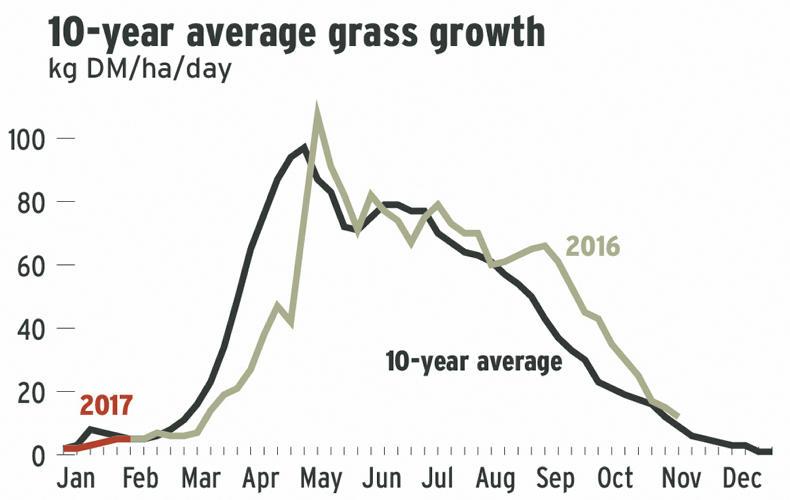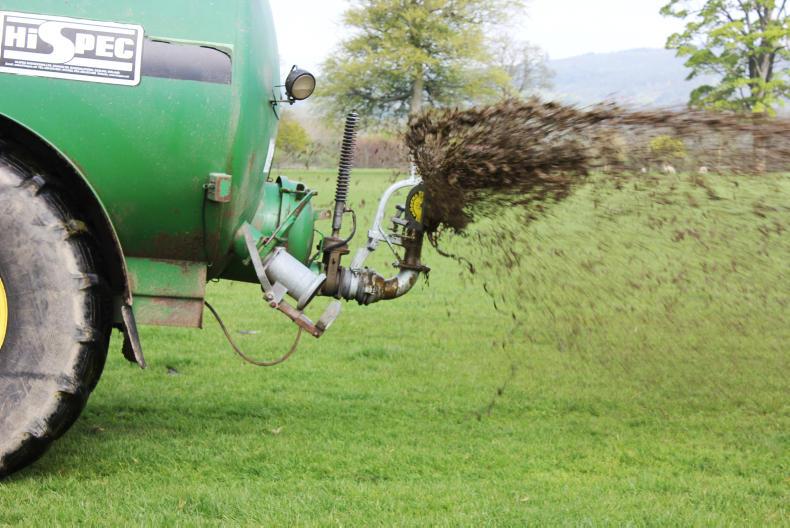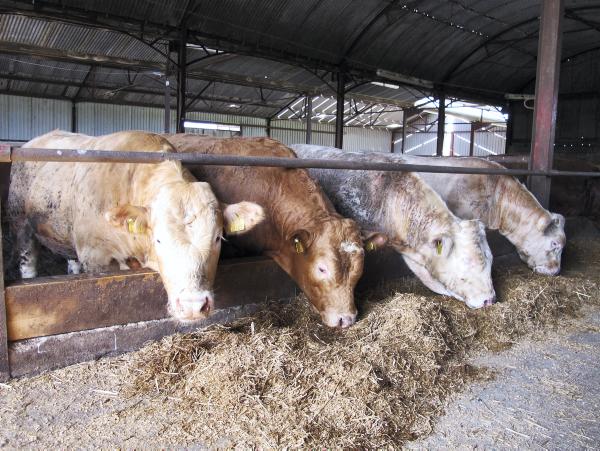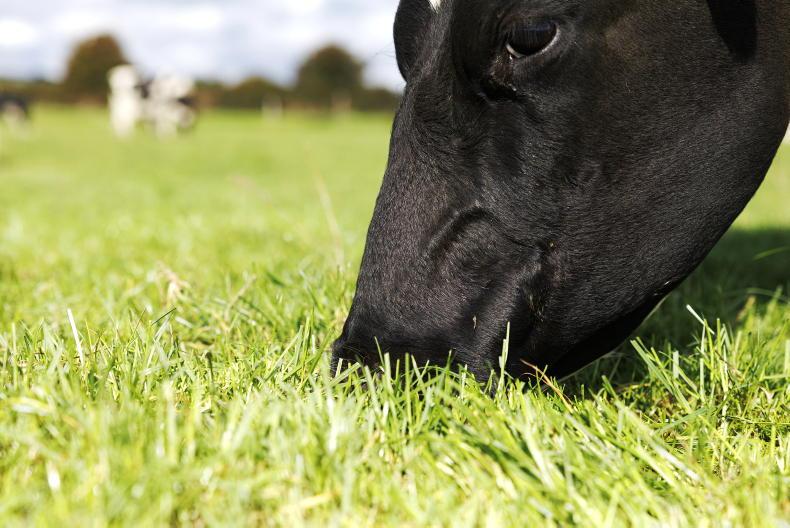For farmers in Nitrates Zones A and B, January has been a dream for getting slurry and fertiliser out. Contractors are reporting near-perfect ground conditions in many places and that they have been able to access ground that would not traditionally have been trafficable in January.
Thankfully for those in Zones C and D (Donegal, Cavan, Monaghan, Leitrim) and Northern Ireland rain over the weekend and early this week was concentrated in the southern half of the country.
However, it did creep north,and parts of Cavan and Leitrim experienced half an inch of rain on Monday evening.
This will set those on wetter ground back seven to 10 days with slurry spreading, with many lamenting the fact that conditions have been perfect for a fortnight up to now.
The message around grass in the springtime is clear: grow it now, while you can.
Slurry should be targeted towards lower grass covers on the farm, with urea going on heavier covers.
While slurry spreading will be seen as opening a release valve for many, do not underestimate its nutrient value.
Undiluted (7% dry matter) cattle slurry spread at a rate of 2,000 gallons/acre in the springtime has an N-P-K value of 12-10-60 if spread via splash plate and 20-10-60 where a trailing shoe or band spreader is used.
If buying these nutrients, it’s worth about €50 per acre as a fertiliser at this rate.
In terms of fertiliser-N spreading, farms stocked at or slightly above organic nitrates limits should aim to get 60 to 70 units of N out per acre between now and the first week in April.
However, all grassland farmers should grasp the chance to get spreading now, while ground conditions are decent.
On lowly stocked farms that licked the grazing platform clean – as opposed to following an autumn planner in the back end – it is vital that we get fertiliser out now in order to have sufficient grass for both young stock and freshly calved cows and their calves in the coming weeks.
The advice to all farms would be to go with a half bag of urea on the heavier covers ASAP.
![]() Click here for full-size map
Click here for full-size map

Grange, Co Meath
Average farm cover: 750kg DM/haWe had growth of 4kg DM/ha since November and current farm cover is 750kg DM/ha. Slurry was spread on 30% of the farm using a trailing shoe, and a half bag of urea was spread on the remainder of the farm on 25 January. At the time of spreading, ground conditions were suitable with no damage to the ground, though conditions have since deteriorated due to the recent rainfall.
The average weight of the heifers and bullocks is currently 350kg and 390kg respectively and performance is on par with 2016 figures. Both heifers and bullocks are receiving 75% DMD grass silage and a barley-based concentrate at a rate of 1.5kg daily.
The performance of our bulls destined for slaughter under-16 months is also on par with 2016 performance, with an average weight of 440kg. Bulls are currently being offered ad-lib access to barley-based concentrate and are being provided with a restricted supply of grass silage as a source of fibre.
Calving commenced with a Limousin-cross heifer calving early to the Angus sire Tubridmore Gizmo (RGZ).

Co Meath
Average farm cover: 750kg DM/haI walked the farm last week and am happy with how grass is looking for the coming spring. The average farm cover at the moment is 750kg DM/ha. Ground conditions here are good. However, heavy rain on Monday night has left underfoot conditions much softer than last week.
Paddocks that I closed up on 1 October have average covers of 1,060kg DM/ha and I will target these for early grazing, with my spring 2016-born heifers earmarked to be out first around 10 February. Shortly after that I hope to get out heifers for breeding and then the summer-born bulls and heifers, which will be fully weaned by then.
I spread the lighter covers, which wouldn’t have been closed up until the end of October, with 2,000 gallons/acre of watery slurry on the 20 January. I plan on going with 23 units of urea on the whole farm next week and with soil temperatures climbing over 7o°C I hope to see a response from that soon after.

Co Longford
Average farm cover: 550kg DM/haWe walked the farm on Monday and I am surprised at how good ground conditions are. I have covers of 487kg to 660kg DM/ha. My last measurement of 2016 was on 17 November, and I calculated that grass has grown 9kg DM/ha each day since then.
As it stands, I could consider letting out cattle. However, last year I raced out and got caught by the weather . As a result, I ended up having to re-house twice over February and March. I plan to let out my weanling bulls first. They are currently 300kg to 350kg, but I think I will hold out a little longer due the bad forecast.
On 19 January I spread 30 units of urea on paddocks over 7cm and I reckon this should do until the end of February. For any covers under 7cm, I spread 1,500 to 1,800 gallons/acre of slurry on 25 January. I used a product in the slurry this time to help agitating and I found it worked very well to break down lumps.

Co Cork
I don’t think I have ever seen as good a winter period as the one gone by, and now I have savage grass covers here on the farm.
Ground conditions were excellent over January and I went places I’d never go in the tractor. Unfortunately, we have had up to 45mm of rain over the last week and as a result, ground is the wettest it has been all winter.
My slatted tanks are half empty now as I went with slurry last week. I spread 3,000 gallons/acre of watery slurry on the lighter grass covers. I put around 3ft of water into the tanks prior to spreading. I have found that the watery slurry will not stick to or stain the grass. I recently blanket-spread the farm with 25 units of urea as well.
I closed off paddocks around 1 October last year and, as a result, I will have very strong covers of grass for my cows and calves, which will go straight out as they begin calving in the next couple of days. I am also hoping to let my bulling heifers out before the weekend.

Read more
Grass+ dairy: super winter growth means farms well set up
For farmers in Nitrates Zones A and B, January has been a dream for getting slurry and fertiliser out. Contractors are reporting near-perfect ground conditions in many places and that they have been able to access ground that would not traditionally have been trafficable in January.
Thankfully for those in Zones C and D (Donegal, Cavan, Monaghan, Leitrim) and Northern Ireland rain over the weekend and early this week was concentrated in the southern half of the country.
However, it did creep north,and parts of Cavan and Leitrim experienced half an inch of rain on Monday evening.
This will set those on wetter ground back seven to 10 days with slurry spreading, with many lamenting the fact that conditions have been perfect for a fortnight up to now.
The message around grass in the springtime is clear: grow it now, while you can.
Slurry should be targeted towards lower grass covers on the farm, with urea going on heavier covers.
While slurry spreading will be seen as opening a release valve for many, do not underestimate its nutrient value.
Undiluted (7% dry matter) cattle slurry spread at a rate of 2,000 gallons/acre in the springtime has an N-P-K value of 12-10-60 if spread via splash plate and 20-10-60 where a trailing shoe or band spreader is used.
If buying these nutrients, it’s worth about €50 per acre as a fertiliser at this rate.
In terms of fertiliser-N spreading, farms stocked at or slightly above organic nitrates limits should aim to get 60 to 70 units of N out per acre between now and the first week in April.
However, all grassland farmers should grasp the chance to get spreading now, while ground conditions are decent.
On lowly stocked farms that licked the grazing platform clean – as opposed to following an autumn planner in the back end – it is vital that we get fertiliser out now in order to have sufficient grass for both young stock and freshly calved cows and their calves in the coming weeks.
The advice to all farms would be to go with a half bag of urea on the heavier covers ASAP.
![]() Click here for full-size map
Click here for full-size map

Grange, Co Meath
Average farm cover: 750kg DM/haWe had growth of 4kg DM/ha since November and current farm cover is 750kg DM/ha. Slurry was spread on 30% of the farm using a trailing shoe, and a half bag of urea was spread on the remainder of the farm on 25 January. At the time of spreading, ground conditions were suitable with no damage to the ground, though conditions have since deteriorated due to the recent rainfall.
The average weight of the heifers and bullocks is currently 350kg and 390kg respectively and performance is on par with 2016 figures. Both heifers and bullocks are receiving 75% DMD grass silage and a barley-based concentrate at a rate of 1.5kg daily.
The performance of our bulls destined for slaughter under-16 months is also on par with 2016 performance, with an average weight of 440kg. Bulls are currently being offered ad-lib access to barley-based concentrate and are being provided with a restricted supply of grass silage as a source of fibre.
Calving commenced with a Limousin-cross heifer calving early to the Angus sire Tubridmore Gizmo (RGZ).

Co Meath
Average farm cover: 750kg DM/haI walked the farm last week and am happy with how grass is looking for the coming spring. The average farm cover at the moment is 750kg DM/ha. Ground conditions here are good. However, heavy rain on Monday night has left underfoot conditions much softer than last week.
Paddocks that I closed up on 1 October have average covers of 1,060kg DM/ha and I will target these for early grazing, with my spring 2016-born heifers earmarked to be out first around 10 February. Shortly after that I hope to get out heifers for breeding and then the summer-born bulls and heifers, which will be fully weaned by then.
I spread the lighter covers, which wouldn’t have been closed up until the end of October, with 2,000 gallons/acre of watery slurry on the 20 January. I plan on going with 23 units of urea on the whole farm next week and with soil temperatures climbing over 7o°C I hope to see a response from that soon after.

Co Longford
Average farm cover: 550kg DM/haWe walked the farm on Monday and I am surprised at how good ground conditions are. I have covers of 487kg to 660kg DM/ha. My last measurement of 2016 was on 17 November, and I calculated that grass has grown 9kg DM/ha each day since then.
As it stands, I could consider letting out cattle. However, last year I raced out and got caught by the weather . As a result, I ended up having to re-house twice over February and March. I plan to let out my weanling bulls first. They are currently 300kg to 350kg, but I think I will hold out a little longer due the bad forecast.
On 19 January I spread 30 units of urea on paddocks over 7cm and I reckon this should do until the end of February. For any covers under 7cm, I spread 1,500 to 1,800 gallons/acre of slurry on 25 January. I used a product in the slurry this time to help agitating and I found it worked very well to break down lumps.

Co Cork
I don’t think I have ever seen as good a winter period as the one gone by, and now I have savage grass covers here on the farm.
Ground conditions were excellent over January and I went places I’d never go in the tractor. Unfortunately, we have had up to 45mm of rain over the last week and as a result, ground is the wettest it has been all winter.
My slatted tanks are half empty now as I went with slurry last week. I spread 3,000 gallons/acre of watery slurry on the lighter grass covers. I put around 3ft of water into the tanks prior to spreading. I have found that the watery slurry will not stick to or stain the grass. I recently blanket-spread the farm with 25 units of urea as well.
I closed off paddocks around 1 October last year and, as a result, I will have very strong covers of grass for my cows and calves, which will go straight out as they begin calving in the next couple of days. I am also hoping to let my bulling heifers out before the weekend.

Read more
Grass+ dairy: super winter growth means farms well set up





















SHARING OPTIONS